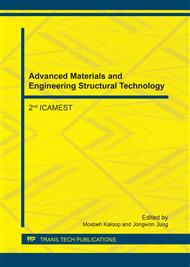[1]
K. Liu, Z. G. Su, S. D. Miao, et al, UV-curable enzymatic antibacterial waterborne polyurethane coating, Biochem. Eng. J. 113 (2016) 107-113.
DOI: 10.1016/j.bej.2016.06.004
Google Scholar
[2]
Z. Ge, C. Huang, C. Zhou, et al, Synthesis of a novel UV crosslinking waterborne siloxane–polyurethane, Prog. Org. Coat. 90 (2016) 304-308.
DOI: 10.1016/j.porgcoat.2015.10.011
Google Scholar
[3]
J. Y. Dai, S. Q. Ma, Y. G. Wu, et al, High bio-based content waterborne UV-curable coatings with excellent adhesion and flexibility, Prog. Org. Coat. 87 (2015) 197-203.
DOI: 10.1016/j.porgcoat.2015.05.030
Google Scholar
[4]
O. Llorente, M. J. Fernandez-Berridi, A. Gonzalez, et al, Study of the crosslinking process of waterborne UV curable polyurethane acrylates, Prog. Org. Coat. 99 (2016) 437-442.
DOI: 10.1016/j.porgcoat.2016.06.020
Google Scholar
[5]
B. Ghosh, S. Gogoi, S. Thakur, et al, Bio-based waterborne polyurethane/carbon dot nanocomposite as a surface coating material, Prog. Org. Coat. 90 (2016) 324-330.
DOI: 10.1016/j.porgcoat.2015.10.025
Google Scholar
[6]
R. Herrera, M. Muszynska, T. Krystofiak, et al, Comparative evaluation of different thermally modified wood samples finishing with UV-curable and waterborne coatings, Appl. Surf. Sci. 357 (2015) 1444-1453.
DOI: 10.1016/j.apsusc.2015.09.259
Google Scholar
[7]
L. Poussard, J. Lazko, J. Mariage, et al, Biobased waterborne polyurethanes for coating applications: How fully biobased polyols may improve the coating properties, Prog. Org. Coat. 97 (2016) 175-183.
DOI: 10.1016/j.porgcoat.2016.04.003
Google Scholar
[8]
M. V. Cristea, B. Riedl, P. Blanchet, Enhancing the performance of exterior waterborne coatings for wood by inorganic nanosized UV absorbers, Prog. Org. Coat. 69(4) (2010) 432-441.
DOI: 10.1016/j.porgcoat.2010.08.006
Google Scholar
[9]
X. Z. Gao, H. J. Liu, F. Cheng, et al, Thermoresponsive polyaniline nanoparticles: Preparation, characterization, and their potential application in waterborne anticorrosion coatings, Chem. Eng. J. 283 (2016) 682-691.
DOI: 10.1016/j.cej.2015.08.015
Google Scholar
[10]
J. Miklecic, S. L. Blagojevic, M. Petric, et al, Influence of TiO2 and ZnO nanoparticles on properties of waterborne polyacrylate coating exposed to outdoor conditions, Prog. Org. Coat. 89 (2015) 67-74.
DOI: 10.1016/j.porgcoat.2015.07.016
Google Scholar
[11]
X. Wang, D. Xue, Direct observation of the shape evolution of MgO whiskers in a solution system, Mater. Lett. 60(25-26) (2006) 3160-3164.
DOI: 10.1016/j.matlet.2006.02.066
Google Scholar
[12]
H. D. Hwang, J. I. Moon, J. H. Choi, et al, Effect of water drying conditions on the surface property and morphology of waterborne UV-curable coatings for engineered flooring, J. Ind. Eng. Chem. 15(3) (2009) 381-387.
DOI: 10.1016/j.jiec.2008.11.002
Google Scholar
[13]
S. Veigel, G. Grull, S. Pinkl, et al, Improving the mechanical resistance of waterborne wood coatings by adding cellulose nanofibres, React. Funct. Polym. 85 (2014) 214-220.
DOI: 10.1016/j.reactfunctpolym.2014.07.020
Google Scholar
[14]
H. Z. Liao, B. Zhang, L. H. Huang, et al, The utilization of carbon nitride to reinforce the mechanical and thermal properties of UV-curable waterborne polyurethane acrylate coatings, Prog. Org. Coat. 89 (2015) 35-41.
DOI: 10.1016/j.porgcoat.2015.07.021
Google Scholar


